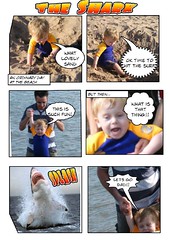How do i use Comic Life?
I have blogged here before about Comic Life, it is an application which allows students (and teachers) to create comic strips very easily. I have seen it sitting idly as an icon on many a desktop and it surprises it isn't used more.
Here are a few thoughts on how it could be used :
For teachers using Comic Life this could be a very lucid and coherent means of communicating their INSET message to their colleagues-people will thank you for a simple handout of 'key messages told visually, rather than a clutch of staples A4s that will get annotated and doodle on, but probably little more.
Consider also making a very visual training guide for that new visualiser, printer or other gadget in Comic Life. Display this next to the equipment could mean colleagues are less dependent on you.
And for Pupil Use
- In a Special school it would provide an easy context for the creation of Social stories, which help to support children in understanding appropriate behaviour or a set of instructions. Put simply picture of a particular routine such as lunchtimes(e.g. washing hands, walking to dinner room) could be taken, in order to help break down the task into its component steps.
- The filters in the software will allow you to create a Warhol style digital painting -
- During Science lessons, children are often made to write out reams on the method, the results and then the conclusions, sometimes this can even be a dictation exercise. Comic life could be used here as a more creative communication tool to record findings.
- In one of our schools- it is used extensively and enthusiastically in Key Stage 2 alongside BFI films- still are captured and used in comic strips - pictures and more details to follow soon
- The Renewed Framework for Literacy has a number of reference to the use of comics and therefore it offers us some further context for use, look at:
- Key Stage 1- Additional Text Unit, here children use an RSPCA resource, 'The Story of Jake and Bones, which is an interactive text told through a comic strip. During the teaching sequence, children get the opportunity to use ICT to capture freeze frames in drama/retelling, before going on to write the story in comic strip format:
See the extract from Phase 3 of this Literacy Unit below:
- Shared writing – teacher to model capture of ideas from freeze-frame sessions into short sentences, involving children in the writing process. Use a presentation/IWB to add the children's contributions to the story.
- Using the comic strip version of Jake and Bones, children add their own thoughts, in simple sentences, to some of the characters as an independent task.
Use further freeze-frame activities to represent significant moments in the story. Together the children decide the correct order in which to sequence the scenes to reflect the development of the story. - Teacher to model retelling of the story, selecting one of the possible endings. Allow opportunities for children to engage in the retelling of the story to each other. Encourage them to select alternative endings.
- Children produce a written version of the story ending, using the comic strip style that will now be familiar to them.
Useful Links
Mac instruct - How to Use Comic Life in the Classroom - this site gives information on the background of comics and why we should use them in the curriculum, along with some practical uses for the application in writing.








1 comment:
Hi Anthony,
Love that you are a champion for Comic Life. I agree that it is underutilized in many schools.
Here are two resources for some other ideas and resources for Comic Life use in schools: http://bit.ly/2KVNPf and http://bit.ly/3W0leH
Post a Comment